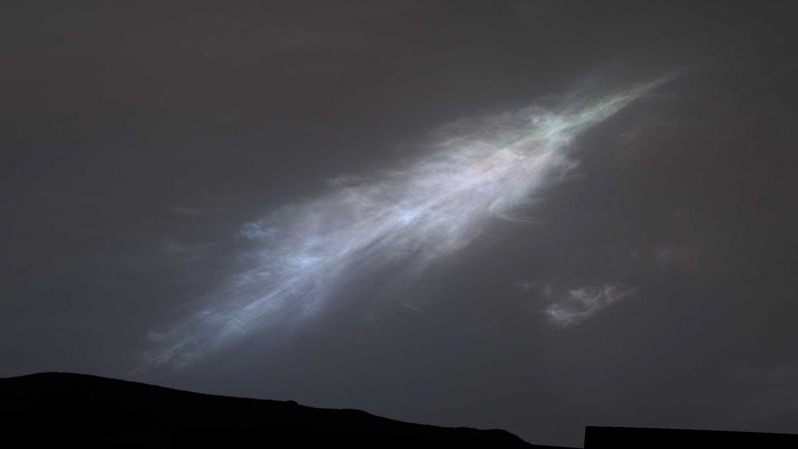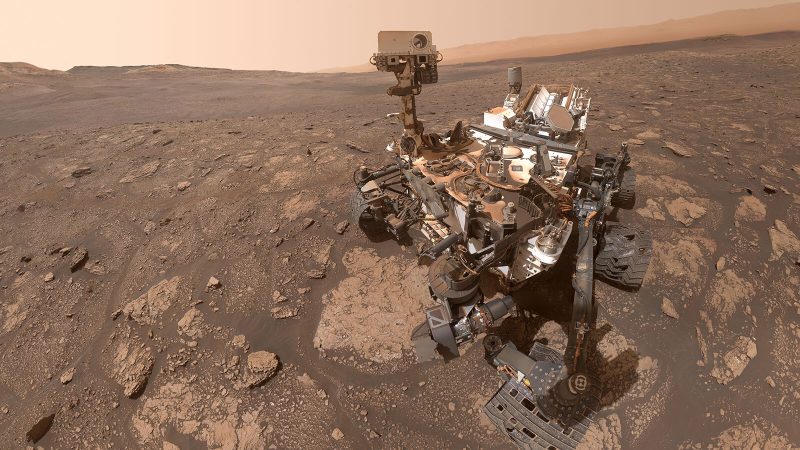Sunrays on Mars
NASA released the photographs above and beneath on March 6, 2023, saying its veteran Curiosity rover has captured our first-ever clear take a look at sunrays on Mars. It caught the photographs throughout a stunning sundown, and through a brand new cloud-imaging marketing campaign. NASA stated:
Martian sunsets are uniquely moody. However NASA’s Curiosity rover captured one final month that stands out. Because the sun descended over the horizon on February 2, rays of sunshine illuminated a financial institution of clouds. These sunrays are often known as crepuscular rays, from the Latin phrase for ‘twilight.’
It was the primary time sunrays have been so clearly considered on Mars.

Feather-shaped iridescent clouds on Mars
Now take a look at the picture above. Discover the refined colours. This feather-shaped cloud is an iridescent cloud on Mars: a cloud that shows rainbow colours. Curiosity captured this picture just lately, too, on January 27, 2023.
There are lots of varieties of rainbow-like clouds on Earth – and possibly on Mars, too – together with halos and coloured arcs. However randomly distributed rainbow colours in a cloud point out cloud iridescence. Atmospheric scientist Mark Lemmon of the Area Science Institute in Boulder, Colorado explained:
The place we see iridescence, it means a cloud’s particle sizes are similar to their neighbors in every a part of the cloud.
By coloration transitions, we’re seeing particle measurement altering throughout the cloud. That tells us about the way in which the cloud is evolving and the way its particles are altering measurement over time.
NASA stated that Curiosity captured each the sun rays and iridescent clouds as panoramas, every of which was stitched collectively from 28 photos despatched to Earth.
The pictures have been processed to emphasise the highlights.
New twilight cloud survey on Mars
In 2021, Curiosity carried out a marketing campaign to watch noctilucent, or night-shining, clouds on Mars. However, since January 2023, the rover has been turning its imaging energy to a brand new twilight cloud survey. NASA defined:
Whereas most Martian clouds hover not more than 37 miles (60 km) above the bottom and are composed of water ice, the clouds within the newest photos seem like at a better altitude, the place it’s particularly chilly. That implies these clouds are product of carbon dioxide ice, or dry ice.
As on Earth, clouds present scientists with advanced however essential info for understanding the climate. By when and the place clouds kind, scientists can be taught extra in regards to the Martian environment’s composition and temperatures, and the winds inside it.
The 2021 cloud survey included extra imaging by Curiosity’s black-and-white navigation cameras, offering an in depth take a look at a cloud’s construction because it strikes.
However the current survey, which started in January and can wrap up in mid-March, depends extra usually on the rover’s coloration Mast Digital camera, or Mastcam, which helps scientists see how cloud particles develop over time.
Meet the robotic photographer

Backside line: NASA’s Curiosity rover has captured our 1st clear picture of crepuscular rays or sunrays on Mars. The rover additionally caught cloud iridescence on Mars. The pictures are a part of a brand new twilight cloud survey, being carried out now by Curiosity.



